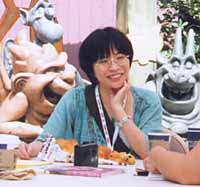Akadot: Let's gracefully segue way into something else - given the proliferation of female characters in fanciful settings in both anime at large and in the book of your artwork, "Misty Orb," and given that several other female artists this weekend have expressed an affinity for romantic settings, what is the root in Japanese culture for the attraction to these fanciful settings- unicorns, castles, princes etc... Takada: It's not a cultural thing but more of a gender thing. Men think in terms of logic etc, and women think in terms of emotion. When men think logically, the sensitivity is lost, so that is why, image-wise, the castles and unicorns appear in the work of women. Akadot: Do you ever watch anime of different genres, like mecha or horror, and feel elements of sensitivity that maybe exist in your own work? Takada: I have stopped watching anime ever since I started working for Studio Pierrot. Akadot: All anime? Takada: I still watch my own (laughs). Akadot: At your panel you mentioned an illustrator named Alphonse Mucha, a Czech illustrator from around the turn of the century, as one of your inspirations. If we were analyzing a Baroque or Romantic or Renaissance image, we would comment on the light source, level of realism, etc. We also recognize an increasing trend towards naturalism as art moves into the classical era. What about Alphonse Mucha's illustrations draws your interest and admiration? Takada: Color, harmony, construction and the composition. The character being placed in the middle, flowers all around the edges, lots of curves, flowers blooming, the facial lines that appeal to the Japanese eye. The Japanese style is more shadow and light, whereas Mucha is blended. Akadot: What are Mucha's subjects? Takada: He drew humans, but with plants in the background, and in the art nouveau style, very organic. He did pamphlets and posters and the layouts for books. He even did the design for a restaurant menu. He also made accessories and, so, he's like a...(laughs) super star designer. Akadot: What about the lines of the cheeks? What is important in the face? In Mucha's, work does he use any characteristics in the face to emphasize points? Takada: He paints very realistically. Akadot: In anime, so much effort is put into the rendering of the eyes, sparkles, a lot of detail. Is there a cultural or mythical fascination with the eyes in Japanese culture? Takada: I think there is. In general, Japanese culture is, and myself in particular. Universally, though, there is a saying that the eyes are the windows to the soul. Akadot: Then what are you saying when you render a man with sunglasses such as Seitaro Sakaki from "Patlabor?" Was that a choice by you or did the director say that he wanted this man designed with sunglasses? Takada: I don't think I came up with it but it was so long ago I can't really remember. It does, though, separate him from the other characters. Akadot: So is it that he's hiding his heart or soul? Takada: It's not that intentional. He's more doing it to dress nicely. Akadot: Do you like drawing landscapes? Takada: I tolerate it. It's bothersome. I would rather draw people. Akadot: To what extent do you feel the background affects the character in the foreground? Like in the drawing of Madoka in front of the mirror? Takada: If it is necessary for the character I will draw it. But there is a handy thing called Macs nowadays (laughs). Akadot: So I've heard. Reading the "Patlabor" character descriptions I noted that it lists where people are from. To what extent does that make it into the character design? Takada: For the Japanese, where you are from has a lot to do with your personality, like your overall self. People come up with an image of a person as soon as they know where he or she is from. Akadot: As a last question, you seem to be very self-deprecating about your own work. Are you happy with the drawings you have produced? Are you happy with "Misty Orb?" Is it your best work? Takada: I don't like to think about things in terms of being the best, but if I draw naturally, this ("Misty Orb") is the type of art I come up with. Akadot: Do you ever talk to or teach younger artists? Takada: No. Because I am still studying myself. Akadot: Do you feel like you will always be studying? Takada: Always. An entire interview probing her for a definition of the Takada style yields a diplomatic and knowing evasion of the question. This, above all else, characterizes Takada Akemi - ineffably rising beyond clumsy words and indulgent egos to reflect her true, unadulterated essence. Visit Takada Akemi's website at http://www.cri.co.jp/cap/a-takada/
Takada Akemi prefers to have her name written in the traditional
Japanese style, with her surname first. |

